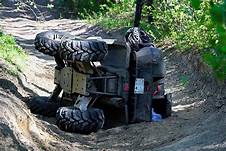Wrecking Wheels: ATV Dangers

November 15, 2019
It seems everybody everywhere has heard a story about the danger of all-terrain vehicles (ATVs). The stories are as numerous and devastating as the vehicles themselves. ATVs are any “off-road” vehicle, including mopeds, go carts, dirt bikes, and the typical four-wheelers most associate with the term.
ATVs are most common in the South, where families live on lots of acreage and can easily have fun on trails without disturbing those around them. They’ve become the “new toy” and are often purchased for Christmas and birthdays. As a result of their popularity, accidents involving ATVs have tripled. (There are even two-seater options available now, making the danger that much greater by putting two at risk.)
The most popular motor vehicle companies are Polaris, Yamaha, Artic Cat, and Kawasaki. In 2018, 8.11% of 18 to 29-year old’s had an ATV, and 11.85% of 39 to 40-year old’s had one.
The Consumer Product Safety Commission states that the most common ATV injuries involve Traumatic brain injuries and spinal cord injuries. Nearly 75% of all crashes are connected with one of the two injuries, if not both.
Teenagers and young adults make up a majority of the accidents and injuries. They often don’t take the dangers seriously. A harmful accident takes only a second to happen, but can impact an individual or their survivors for a lifetime.
Many companies claim their ATVs are the safest, with such features as heavy duty seatbelts, sturdier wheels, or head guards. But these ATVs can weigh between 220-1170 pounds and some can reach speeds of 100 mph, making it easy for the vehicle to get out of control, flip from a pothole, wrap around a tree, or land upside down in a ditch, like many of the accidents that have been reported. A lot of accidents reported are from horse play on forty-five mile per hour two lanes where ATVs are not allowed.
In recent months, there have been two local deaths related to ATVs. One involved a woman who was riding her four wheeler when she lost control and wrecked into a tree. She was young, with two children, and because of a freak accident, her kids no longer have a mother.
One of her coworkers: “Nothing feels the same anymore. We all said goodbye to her Friday as she wished us a good weekend and the next thing, we are having job applications to fill in her spot. She had such a fun and sweet soul, which made it fun to work with her no matter how busy the day was. You’d expect to hear that someone died from medical conditions or other natural events, not from being crushed by an ATV. It had us all surprised.”
As ATVs continue to become “bigger and better,” there WILL need to be more safety rules to protect riders. There should be hands-on training courses. It’s amazing how many people just jump on an ATV without knowing fully how to control it. These courses would lower crash rates.
Wearing protective gear like helmets, gloves, shoes, and heavy suits to protect from skinning on the road, can reduce injuries. Another safety rule needing to be enforced is has to do with passengers. If an ATV doesn’t specifically have two seats for a passenger, then never add another person to the ride. This adds weight, making it easier to flip. Lastly, paved roads or highways are never the place to ride ATVs; they are made for trails. However, even on trails, particularly rugged ones, an ATV may be subject to flipping.
Atvs are very fun and they are a huge reason why the south is the south. With just a little more caution, atvs could be a safe and fun way to make memories.


